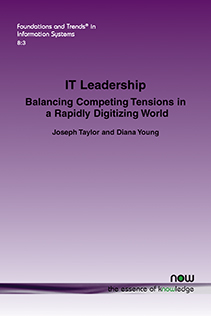IT Leadership: Balancing Competing Tensions in a Rapidly Digitizing World
By Joseph Taylor, California State University, Sacramento, USA, joseph.taylor@csus.edu | Diana Young, Trinity University, San Antonio, USA, dyoung1@trinity.edu
Abstract
In modern organizations, Information Technology (IT) leaders wear many hats. They are technicians responsible for overseeing specialized tools that organizations use to conduct operations, defenders protecting the organization from outside threats, teambuilders developing specialized talent to support organizational needs, strategists leveraging emerging technology to disrupt markets, and administrators overseeing large capital and operating budgets. Additionally, technology evolves rapidly such that IT leaders must frequently make decisions about products and approaches that have no generally accepted best practices, regarding topics where much of the publicly available information is produced by the providers of the very technology under consideration. The study of IT leadership provides unique value to the Information Systems (IS) discipline in three distinct ways. First, it can provide IT leaders with practical insights regarding emerging phenomena through analysis conducted by scholars without the conflicts of interest that are inherent in the information provided by vendors of IT products and services. Second, the study of IT leadership can conceptualize and address IS related questions and issues from the perspective of an administrative leader. Third, the study of IT leadership can help identify ways that IT leaders can grow, develop, and improve as business professionals. This monograph provides a summary of the extant research literature concerning IT leadership and the unique challenges that those professionals face.
IT Leadership: Balancing Competing Tensions in a Rapidly Digitizing World
In an era where technology drives both day-to-day operations and strategic innovation, the role of IT leaders has become increasingly complex. IT Leadership: Balancing Competing Tensions in a Rapidly Digitizing World delves into the unique challenges IT leaders face, balancing their responsibility for leveraging technology to drive performance while managing specialized teams and budgets. IT leaders must navigate organizational tensions, manage "shadow IT" initiatives, and make critical decisions amid rapid technological changes like AI and cloud computing. Drawing on recent studies, this monograph explores the evolving expectations of IT leaders and provides insights on how to manage the growing demands of modern organizations.
The monograph begins with a review of the IT leadership literature by first discussing the various domains of scholarship that address IT leadership questions. The authors then review several of the theories that have been used to guide prior IT leader research. The monograph examines several of the contemporary issues and administrative challenges that IT leaders face. Finally, the authors conclude with suggestions for future examination. Whether you are an aspiring or seasoned IT leader, this work offers invaluable guidance to thrive in the digital age.
